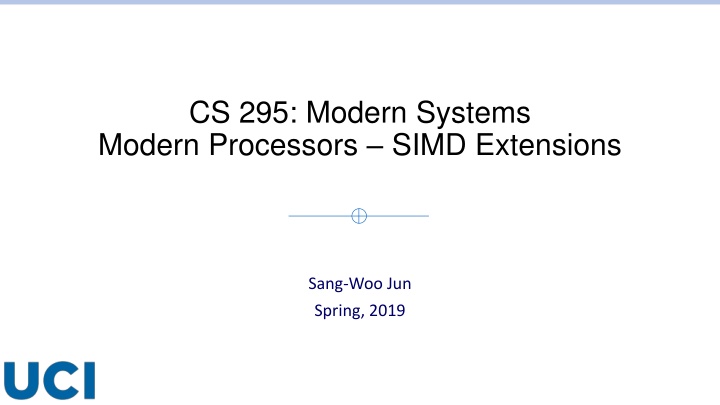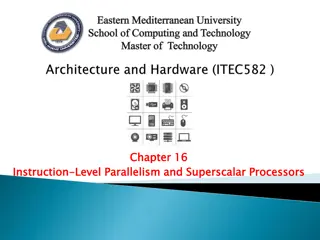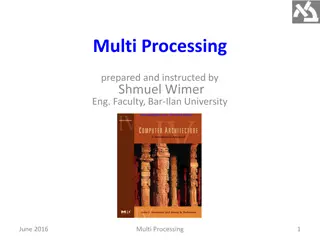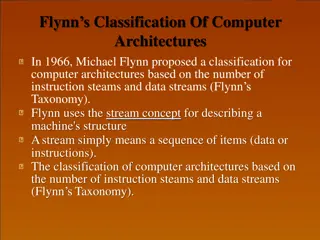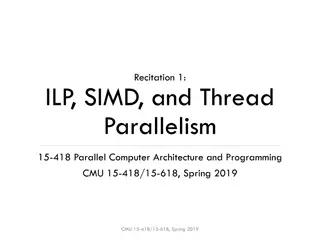CS 295: Modern Systems Modern Processors - SIMD Extensions
This content covers topics on modern processors, including SIMD extensions, performance improvements, Flynn Taxonomy Recap, Intel SIMD extensions, registers, SSE/AVX data types, and Sandy Bridge Microarchitecture. It provides insights into transparent performance improvements, explicit performance enhancements, and Intel's new instructions and registers. The Flynn Taxonomy Recap explains the classification of data and instruction streams in different processor architectures. Explore the evolution of processors and advancements in SIMD technology.
Uploaded on Mar 01, 2025 | 0 Views
Download Presentation

Please find below an Image/Link to download the presentation.
The content on the website is provided AS IS for your information and personal use only. It may not be sold, licensed, or shared on other websites without obtaining consent from the author.If you encounter any issues during the download, it is possible that the publisher has removed the file from their server.
You are allowed to download the files provided on this website for personal or commercial use, subject to the condition that they are used lawfully. All files are the property of their respective owners.
The content on the website is provided AS IS for your information and personal use only. It may not be sold, licensed, or shared on other websites without obtaining consent from the author.
E N D
Presentation Transcript
CS 295: Modern Systems Modern Processors SIMD Extensions Sang-Woo Jun Spring, 2019
Modern Processor Topics Transparent Performance Improvements o Pipelining, Caches o Superscalar, Out-of-Order, Branch Prediction, Speculation, o Covered in CS250A and others Explicit Performance Improvements o SIMD extensions, AES extensions, o Non-Performance Topics o Virtualization extensions, secure enclaves, transactional memory,
Flynn Taxonomy (1966) Recap Data Stream Single Multi Instruction Stream Single SISD SIMD (Single-Core Processors) (GPUs, Intel SSE/AVX extensions, ) Multi MISD MIMD (Systolic Arrays, ) (VLIW, Parallel Computers)
Flynn Taxonomy Recap Single-Instruction Single-Data (Single-Core Processors) Single-Instruction Multi-Data (GPUs, Intel SIMD Extensions) Multi-Instruction Single-Data (Systolic Arrays, ) Multi-Instruction Multi-Data (Parallel Computers)
Intel SIMD Extensions New instructions, new registers Introduced in phases/groups of functionality o SSE SSE4 (1999 2006) 128 bit width operations o AVX, FMA, AVX2, AVX-512 (2008 2015) 256 512 bit width operations AVX-512 chips not available yet (as of Spring, 2019), but soon! F16C, and more to come?
Intel SIMD Registers (AVX-512) XMM0 XMM15 o 128-bit registers o SSE YMM0 YMM15 o 256-bit registers o AVX, AVX2 ZMM0 ZMM31 o 512-bit registers o AVX-512 XMM0 YMM0 ZMM0 XMM1 YMM1 ZMM1 XMM31 YMM31 ZMM31
SSE/AVX Data Types 255 0 YMM0 float float float float float float float float double double double double int32 int32 int32 int32 int32 int32 int32 int32 16 16 16 16 16 16 16 16 16 16 16 16 16 16 16 16 8 8 8 8 8 8 Operation on 32 8-bit values in one instruction! 8 8 8 8 8 8 8 8 8 8 8 8 8 8 8 8 8 8 8 8 8 8 8 8 8 8
Sandy Bridge Microarchitecture e.g., Port 5 pressure when code uses too much shuffle operations
Aside: Do I Have SIMD Capabilities? less /proc/cpuinfo
Processor Microarchitectural Effects on Power Efficiency The majority of power consumption of a CPU is not from the ALU o Cache management, data movement, decoding, and other infrastructure o Adding a few more ALUs should not impact power consumption Indeed, 4X performance via AVX does not add 4X power consumption o FromiI7 4770K measurements: o Idle: 40 W o Under load : 117 W o Under AVX load : 128 W Aside: Not all AVX operations are active at the same time Specialization horseman ?
Compiler Automatic Vectorization In gcc, flags -O3 mavx mavx2 attempts automatic vectorization Works pretty well for simple loops Generated using GCC explorer: https://gcc.godbolt.org/ But not for anything complex o E.g., na ve bubblesort code not parallelized at all
Intel SIMD Intrinsics Use C functions instead of inline assembly to call AVX instructions Compiler manages registers, etc Intel Intrinsics Guide o https://software.intel.com/sites/landingpage/IntrinsicsGuide o One of my most-visited pages e.g., __m256 a, b, c; __m256 d = _mm256_fmadd_ps(a, b, c); // d[i] = a[i]*b[i]+c[i] for i = 0 7
Data Types in AVX/AVX2 Type Description __m128 128-bit vector containing 4 floats __m128d 128-bit vector containing 2 doubles 1~16 signed/unsigned integers __m128i 128-bit vector containing integers __m256 256-bit vector containing 8 floats __m256d 256-bit vector containing 4 doubles 1~32 signed/unsigned integers __m256i 256-bit vector containing integers __m512 variants in the future for AVX-512
Intrinsic Naming Convention _mm<width>_[function]_[type] o E.g., _mm256_fmadd_ps : perform fmadd (floating point multiply-add) on 256 bits of packed single-precision floating point values (8 of them) Width Prefix Type Postfix 128 _mm_ Single precision _ps 256 _mm256_ Double precision _pd 512 _mm512_ Packed signed integer _epiNNN (e.g., epi256) Packed unsigned integer _epuNNN (e.g., epu256) Not all permutations exist! Check guide Scalar integer _siNNN (e.g., si256)
Load/Store/Initialization Operations Initialization o _mm256_setzero_ps/pd/epi32/ o _mm256_set_... o Load/Store : Address MUST be aligned by 256-bit o _mm256_load_... o _mm256_store_... And many more! (Masked read/write, strided reads, etc ) e.g., __mm256d t = _mm256_load_pd(double const * mem); // loads 4 double values from mem to t __mm256i v = _mm256_set_epi32(h,g,f,e,d,c,b,a); // loads 8 integer values to v
Vertical Vector Instructions Add/Subtract/Multiply o _mm256_add/sub/mul/div_ps/pd/epi Mul only supported for epi32/epu32/ps/pd Div only supported for ps/pd Consult the guide! Max/Min/GreaterThan/Equals Sqrt, Reciprocal, Shift, etc FMA (Fused Multiply-Add) o (a*b)+c, -(a*b)-c, -(a*b)+c, and other permutations! o Consult the guide! a b + + + + c = = = = d __m256 a, b, c; __m256 d = _mm256_fmadd_pd(a, b, c);
Integer Multiplication Caveat Integer multiplication of two N bit values require 2N bits E.g., __mm256_mul_epi32 and __mm256_mul_epu32 o Only use the lower 4 32 bit values o Result has 4 64 bit values E.g., __mm256_mullo_epi32 and __mm256_mullo_epu32 o Uses all 8 32 bit values o Result has 8 truncated 32 bit values And more options! o Consult the guide
Horizontal Vector Instructions Horizontal add/subtraction o Adds adjacent pairs of values o E.g., __m256d _mm256_hadd_pd (__m256d a, __m256d b) a b + + + + c
Shuffling/Permutation Within 128-bit lanes o _mm256_shuffle_ps/pd/ (a,b, imm8) o _mm256_permute_ps/pd o _mm256_permutevar_ps/ Across 128-bit lanes o _mm256_permute2x128/4x64 : Uses 8 bit control o _mm256_permutevar8x32/ : Uses 256 bit control Not all type permutations exist, but variables can be cast back and forth Matt Scarpino, Crunching Numbers with AVX and AVX2, 2016
Blend Merges two vectors using a control o _mm256_blend_... : Uses 8 bit control e.g., _mm256_blend_epi32 o _mm256_blendv_... : Uses 256 bit control e.g., _mm256_blendv_epi8 a b ? ? ? ? c
Alignr Right-shifts concatenated value of two registers, by byte o Often used to implement circular shift by using two same register inputs o _mm256_alignr_epi8 (a, b, count) Example of 64-bit values being shifted by 8 a b c
Helper Instructions Cast o __mm256i <-> __mm256, etc o Syntactic sugar -- does not spend cycles Convert o 4 floats <-> 4 doubles, etc Movemask o __mm256 mask to -> int imm8 And many more
Case Study: Sorting Important, fundamental application! Can be parallelized via divide-and-conquer How can SIMD help?
Reminder: Sorting Network Network structure for sorting fixed number of values Type of a comparator network o comparators perform compare-and-swap Easily pipelined and parallelized Example 4-element sorting network 5 comparators, 3 cycle pipelined
Remind: Sorting Network Simple to generate correct sorting networks, but optimal structures are not well-known Some known optimal sorting networks Source: Wikipedia (Sorting Network)
SIMD And Sorting Networks AVX compare/max/min instructions do not work internally to a register o Typically same values copied to two different registers, permuted, compared o Or, two register trick , and many more optimizations In this case, optimal sorting networks are typically not very helpful o Irregular computation means bubbles in the compute structure o Simple, odd-even sorting network works well What if I want to sort more than 8 values? 8-element odd-even sorting network
SIMD And Sorting Networks Typically, we are sorting more than one set of tuples o If we have multiple tasks, we can have task-level parallelism Optimized networks! o Sort multiple tuples at the same time Then we need to transpose the 8 8-element variables o Each variable has a value for each sorting network instance o Non-SIMD works, or a string of unpackhi/unpacklo/blend Instruction 1, 2 (min, max) Instruction 3, 4 (min, max)
SIMD And Sorting Networks Some SIMD instructions have high throughput, but high latency o Data dependency between two consecutive max instructions can take 8 cycles on Skylake o If each parallel stage has less than 4 operations, pipeline may stall Solution: Interleave two sets of parallel 8-tuple sorting o In reality, min/max means even for 4-tuples, pipeline is still filled Source: Instrinsics guide
The Two Register Merge Sort units of two pre-sorted registers, K elements o minv = A, maxv = B o // Repeat K times minv = min(minv,maxv) maxv = max(minv,maxv) // circular shift one value down minv = alignr(minv,minv,imm) Inoue et.al., SIMD- and Cache-Friendly Algorithm for Sorting an Array of Structures, VLDB 2015
SIMD And Merge Sort Hierarchically merged sorted subsections Using the SIMD merger for sorting o vector_merge is the two-register sorter from before What if we want to sort structs? o Instead of min/max, use cmpgt, followed by permute for both key and values o For large values, use <key, index> Inoue et.al., SIMD- and Cache-Friendly Algorithm for Sorting an Array of Structures, VLDB 2015 Typically reports 2x + performance!
Topic Under Active Research! Papers being written about o Architecture-optimized matrix transposition o Register-level sorting algorithm o Merge-sort o and more! Good find can accelerate your application kernel 2x
Case Study: Matrix Multiply Branch : Boser & Katz, CS61C: Great Ideas In Computer Architecture Lecture 18 Parallel Processing SIMD
https://www.intel.com/content/dam/www/public/us/en/documents/ma nuals/64-ia-32-architectures-optimization-manual.pdf
